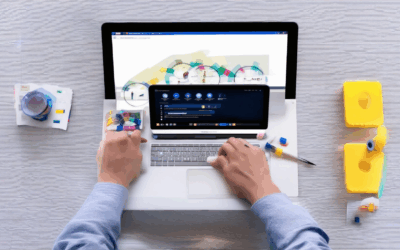In the ever-evolving landscape of web development, mastering effective website prototyping tips is essential for creating intuitive and user-friendly designs. Prototyping serves as a cornerstone for web designers and developers, allowing them to visualize concepts, test ideas, and refine layouts before transitioning into full development. This iterative process not only streamlines the design phase but also ensures alignment between functionality and aesthetics. Whether you’re working on a new project or refining an existing one, understanding the prototyping process can significantly enhance your workflow and deliver superior results. In this comprehensive guide, we’ll explore the key steps, tools, and strategies needed to excel in website prototyping, providing valuable insights for both seasoned professionals and newcomers alike.

What Are the 5 Steps in Prototyping?
Here are the five essential steps involved in the prototyping process:
- Ideation :
Begin by brainstorming and defining the core concepts and features of your project. This stage focuses on generating ideas and refining them into a concrete plan. Use techniques like mind mapping or SWOT analysis to explore possibilities and establish a clear direction. - Wireframing :
Create low-fidelity visual representations of your design. Wireframes outline the layout and structure of your interface, focusing on functionality rather than aesthetics. Tools like pen-and-paper sketches or digital software (e.g., Figma, Sketch) are commonly used during this phase. - Prototyping :
Build a functional prototype that simulates the user experience. This step involves creating interactive models that demonstrate how the product will work. Prototypes can be digital (e.g., InVision, Adobe XD) or physical (e.g., 3D printing), depending on the project’s needs. - Testing :
Gather feedback by testing the prototype with real users or stakeholders. Identify any issues or areas for improvement through usability tests or surveys. This stage helps refine the prototype closer to the final product. - Iteration :
Refine and optimize the prototype based on feedback. Iterate repeatedly until the prototype meets the project’s goals and aligns with user expectations. This step ensures continuous improvement and alignment with the final vision.
By following these steps, teams can efficiently develop and refine their designs, ensuring the final product meets user needs and market demands.
How to Prototype a Website
Prototyping a website is a critical step in the development process, allowing you to visualize and test your ideas before building the final product. Below is a detailed guide to help you create an effective website prototype.
1. Define Your Objectives
Before you begin prototyping, it’s essential to understand the purpose of your website. Clearly define who your target audience is, what goals you aim to achieve, and what features are necessary to meet those goals. Involve stakeholders and prioritize functionality to ensure everyone is aligned.
2. Wireframe the Layout
Wireframing is the foundation of your prototype. Create a basic layout that includes the header, navigation menu, main content area, and footer. Use tools like Figma, Adobe XD, or even pen-and-paper to sketch out your design. Stick to a consistent structure to maintain a cohesive look and feel.
3. Design Visual Assets
Once the layout is set, move on to designing visual elements such as buttons, icons, and color schemes. Choose colors that align with your brand identity and ensure they are consistent across all elements. Typography is also crucial; select fonts that are readable and complementary to your overall design.
4. Develop Front-End Components
With your design ready, it’s time to bring it to life. Implement the front-end using modern frameworks like React, Angular, or Vue.js. Focus on creating reusable components for elements like buttons, menus, and forms. This approach saves time and ensures consistency in your prototype.
5. Test Your Prototype
Testing is a vital part of the prototyping process. Check how your prototype performs across different browsers and devices. Gather feedback from users to identify any issues or areas for improvement. Make adjustments based on their input to refine your design.
6. Iterate and Refine
Prototyping is not a one-time task but an iterative process. Continuously refine your prototype based on feedback and testing results. Look for areas where users struggle and simplify or improve them. Keep track of changes and document why certain decisions were made to aid future development.
7. Document Everything
Finally, create comprehensive documentation to share your prototype with your team or clients. Include details about the design rationale, user flows, and any decisions made during the prototyping process. This documentation will serve as a valuable reference for future development work.
Tools You Might Use
To streamline your prototyping process, consider using tools like:
- Figma for collaborative design
- Adobe XD for advanced prototyping
- Wireflow for interactive wireframes
- Framer for responsive prototypes
By following these steps, you’ll create a well-thought-out website prototype that sets a solid foundation for your project. Remember to iterate and refine based on feedback to ensure your final product meets user needs and expectations.

What Are The 4 Crucial Steps In Creating A Prototype?
Here are the four crucial steps involved in creating a prototype:
- Define Objectives : Clearly outline the purpose of the prototype. Determine what aspects of the product or service you aim to explore. This includes identifying key features, user interactions, and visual elements to focus on during the prototype creation.
- Gather Requirements : Collect necessary information such as user needs, market demands, and technical specifications. Conduct research, analyze competitors, and define the scope of the prototype to ensure it aligns with overall project goals.
- Create a Prototype : Develop a working model, often starting with low-fidelity versions to quickly test ideas. Use tools like pen-and-paper sketches, digital software (e.g., Figma, Sketch), or rapid prototyping techniques to bring concepts to life.
- Test and Iterate : Gather feedback from users or stakeholders to evaluate the effectiveness of the prototype. Make necessary adjustments and improvements based on the insights gained from testing. Repeat this process until the prototype meets its defined objectives.
By following these steps, you can systematically develop a prototype that effectively addresses the problem at hand while incorporating valuable user feedback.

Improving Your Prototyping Skills: A Step-by-Step Guide
To enhance your prototyping abilities, consider the following structured approach:
- Understand the Basics: Begin by grasping the fundamental concepts of prototyping, focusing on creating models or mockups before finalizing products.
- Regular Practice: Dedicate daily time to work on small projects or experiments using tools like Figma or Adobe XD to familiarize yourself with the process and tools.
- Seek Learning Resources: Enroll in online tutorials and courses from reputable platforms. Engage with educational content from experienced designers through videos and written guides.
- Stay Informed Through Reading: Regularly consume articles and blogs from trusted sources to stay updated on trends and techniques in the field.
- Obtain Feedback: Share your prototypes with peers for constructive criticism, ensuring you present your work clearly and prepare to discuss improvements.
- Explore Collaboration Opportunities: Join co-working groups or participate in hackathons to gain collaborative experience, enhancing your ability to work under pressure and with diverse teams.
- Document Your Process: Reflect on your prototyping journey by documenting each step. This practice aids in self-reflection and future communication of your work.
- Broaden Your Perspective: Explore prototyping practices across various industries like gaming or healthcare to gain insights and apply new methodologies to your projects.
- Experiment with Techniques: Try different prototyping methods, starting with low-fidelity for quick iterations and advancing to high-fidelity as you become more comfortable.
- Set Clear Goals: Identify specific areas for improvement, such as user experience design or interactive prototyping, and establish measurable objectives.
- Reflect and Adapt: After each project, conduct a self-evaluation to assess strengths and weaknesses, allowing you to refine your approach for future endeavors.
- Persist and Stay Motivated: Recognize that skill development is gradual. Remain committed, embrace challenges, and celebrate incremental progress to sustain motivation.
By systematically applying these strategies, you can systematically enhance your prototyping capabilities, achieving greater efficiency and creativity in your design processes.
Two Key Elements of Successful Prototyping
Prototyping is a fundamental aspect of design that helps bring ideas to life and gather valuable feedback. Here are two essential elements that contribute to the success of a prototype:
- Clarity and Simplicity : A successful prototype communicates its core concept effectively. It avoids unnecessary details and focuses on the essential elements that convey the intended functionality and user experience. This clarity helps stakeholders understand the vision and provides a solid foundation for further development.
- Iteration and Feedback : Prototyping is not a static process. Successful prototypes allow for iterative refinement based on user feedback and testing. By gathering insights from real users, designers can identify areas for improvement and evolve the prototype into a more polished product.

Best Tool for Prototyping
Prototyping is a critical aspect of product design, enabling designers to visualize ideas and gather feedback before development begins. Several tools stand out for their effectiveness and versatility:
- Figma : A cloud-based prototyping tool renowned for its real-time collaboration capabilities. It allows teams to work together seamlessly, regardless of location, and supports vector graphics and interactive components. Figma’s cross-platform accessibility makes it ideal for remote teams.
- Adobe XD : Part of the Adobe Creative Cloud suite, Adobe XD offers a smooth user interface and integrates well with other Adobe tools like Photoshop and Illustrator. It supports multiple platforms and provides a comprehensive set of features for designing and prototyping.
- Sketch : Known for its simplicity and speed, Sketch is a favorite among designers for creating wireframes and prototypes. While it’s primarily macOS-only, third-party apps like Sketch for Windows can extend its functionality.
- Axure RP : Specializes in creating interactive prototypes with features like state management and annotations. It’s particularly useful for complex projects requiring detailed interactivity.
- Lucidchart : While primarily a wireframing and flowchart tool, Lucidchart excels in visualizing user journeys. It’s a good option for mapping out interactions but may lack some of the advanced features of other tools.
- Invision : Offers a user-friendly interface and free tier plans, making it accessible for small teams or individuals. Invision supports design handoff through shareable links, facilitating easy communication between teams.
Comparison Considerations:
- Collaboration Features: Figma and Adobe XD excel in real-time collaboration, while Invision is noted for its user-friendly interface and free tier.
- Platform Compatibility: Figma and Adobe XD are available across multiple platforms, whereas Sketch is macOS-centric.
- Features: Axure RP offers advanced features for interactive prototypes, making it suitable for complex projects.
Conclusion:
For most users, Figma emerges as the top choice due to its accessibility, collaboration features, and integration capabilities. Adobe XD is a strong alternative, especially for those already using Adobe tools. Depending on specific project needs, Sketch , Axure RP , and Invision can also be valuable options.




0 Comments